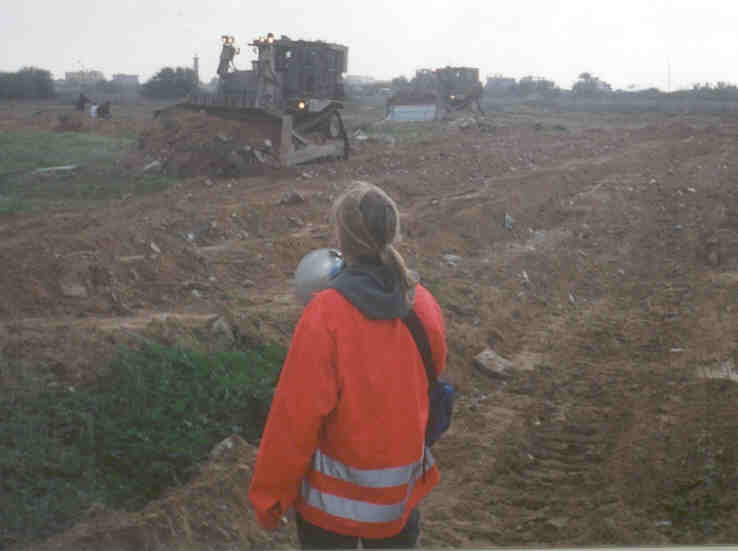Bulldozers and Bombs

By: Barbara Nimri Aziz / Arab America Contributing Writer
Bulldozers, those agile, yellow caterpillar-track hoes, we watch transforming towns, farms, deserts, and suburbs worldwide. But how many of us have seen an Israeli bulldozer at work? Many Palestinians, for certain, rush this way and that to grab furnishings, documents, and clothes from their homes before these redoubtable machines demolish their dwellings.
Nowadays, we may view a newsreel of these enablers of Israel’s colonial agenda following bombers and tanks across Gaza, clearing the way for new Israeli living places. Notwithstanding the efforts of millions of protestors worldwide, legal prosecutions, celebrity appeals, and endless grisly testimonials of the daily slaughter, their work continues unimpeded.
The Occupied Palestinian Territories are a common venue for a super edition of the formidable Israeli bulldozer. There, they lumber through streets on a mission that may not appear connected to Gaza’s leveling. Although it is. They are colossal and cumbersome, fitted with appendages especially designed for their targets. Their unwieldiness does not hamper them. Nor do stones tossed by neighborhood boys. Usually accompanied by fully armed Israeli troops to thwart any resistance, they proceed slowly towards their goal.
I witnessed them at work during an assignment in a West Bank town in 1996. I stood with an evicted family who’d hastily gathered what they could during the previous hour after being notified their home would be destroyed. Theirs was a well-kept stucco house. I remember: 2 stories, potted trees on upper terraces overlooking the street and beds of flowers behind a low outer wall. I wrote not about the monstrous, unstoppable machine but about the symbol of the house to the Palestinian family. It is the domain of the mother and the singular place of refuge for an occupied people. (Even at that time, many Palestinian babies were still delivered in these homes.) I readily recall the enormity of that machine, how it filled the entire landscape while we gazed – shuddering, silent insects gathered on a heap of blankets, clothes, and pots.
With its contracted joints held against its sides to enable freer movement, this monster maneuvers through the narrow streets of West Bank Palestinian towns. Some simply target a designated house, its articulated limb rising to attack it from above. Well-practiced in this task, it ensures nothing but rubble remains at the end of an hour.
High above the mesh-covered body of the machine is a control cabin with its operator, presumably a human being. These machines sprout new features. In a recent photo of one bulldozer, though it’s blurred, having necessarily been taken from some distance away, we can see an array of children’s toys, specifically open-eyed stuffed bears. Hanging on the machine’s protective grate, they must be trophies from homes smashed in earlier exercises. They remind me of the wide-eyed delight of Israeli soldiers inside Gaza homes as they smash and mock their quarry.
Besides those house destroyers are bulldozers that regularly uproot orchards. These efficiently hack and dig up fruit-bearing trees, wiping away the livelihood of Palestinian farmers. They are also protected by troops or armed Israeli settlers eager to expand their property into these useless fields. Anyone daring to stand in the way of this assault is either maimed or killed.
The effect of these machines is multiple. First, they cause the physical destruction of homes and livelihoods. Then comes the humiliation, followed by forced dislocation. As author Ta-Nehisi Coates has affirmed in his many recent discussions of apartheid life in the American Jim Crow era, in South Africa before 1991, and Israel-occupied lands, ‘there is no because’ for such policies. Although we know there will be fatuous, legal justifications proffered by Israeli authorities for this or that killing or displacement.
I use the term killing here determinedly since, at many levels, these actions are part of the genocide process. They kill the place, making it unlivable. They kill the ability of a people to earn a living. They kill hope and foster resistance, which in turn brings more troops and more bulldozers and tanks.
Why write about a machine, you may ask? These cause only the loss of physical structures, while not far away, children are freezing to death, hospitals are reduced to rubble, and whole families are eliminated. Why? Because this is part of the same process – a process of humiliation and the crushing of human agency, a process of ‘clearing’ that forces more and more people to either depart for other countries or move into smaller enclaves, a forced dependence on charity. It has been underway for decades, as long as Israel’s hunger for land, water, rights, supremacy.
I end with an image from a video: for me, it is as sinister and hurtful as the stumps on a wounded child’s torso. It is the arm on the front bumper of an Israeli bulldozer, with an enormous hook at its end. It strikes a road and penetrates a foot or more into the pavement, hooking its claw into the neighborhood street, and eviscerates the entire length of the road. The road is impassable to cars, delivery vans, and regular movement; it’s a mess and hardly repairable since the municipal administration barely exists.
Why is this done? You tell me.
B. Nimri Aziz is a New York based anthropologist and journalist. Her latest book is Justice Stories, a children’s book about Nepali women rebels. Find her work at www.barbaranimri.com.
Check out our blog here!









